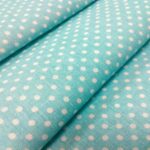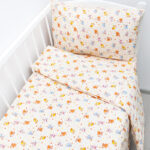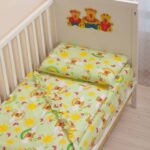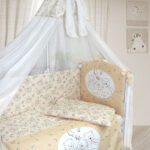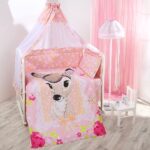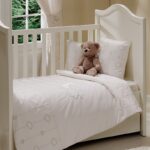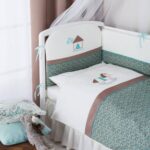How to sew baby bedding yourself
Not a single ready-made set of baby bedding can be compared with a hand-sewn one. Of course, the wide range of products is impressive: bright colors, various textures of fabrics and an abundance of models. But what could be nicer than the process of creating something special for your child?

This option is irreplaceable if the baby's bed has a non-standard shape or size. The ability to independently select fabrics, sizes and patterns will create a unique set. In addition, the cost of materials is significantly lower than the purchase of an industrial model. The recommendations given in this article will help you figure out how to sew baby bedding, even for a beginner who has no experience in sewing.

What should be the bedding for a child
When organizing a children's bed, the main task of parents is to ensure a healthy sleep for the child and a comfortable atmosphere conducive to rest. The correct choice of bedding plays an important role. Lingerie should not only be of high quality, suitable in size, but also cause pleasant sensations in the baby.
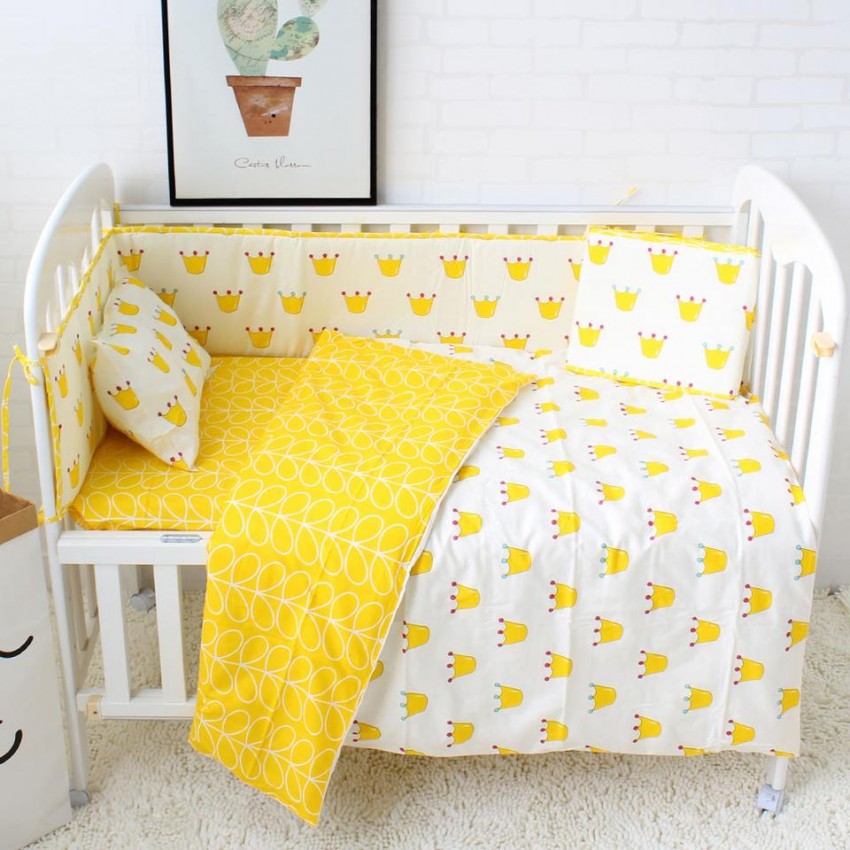
Note! It is recommended to avoid too bright colors when sewing baby bedding in a crib for newborns with your own hands. Contrasting shades can cause aggression and anxiety. Better to give preference to neutral, calm shades.
Sewing baby bedding
The sewing process is not complicated. It does not require any special skills. You should start by measuring the berth. This is necessary for the correct fabric calculation. Next, you need to prepare the following set of sewing tools and accessories:
- The main fabric and denser material for the sides;
- Well-sharpened tailor's scissors;
- Tape measure;
- Pins or invisible pins;
- A chalk or bar of soap;
- Threads;
- Long ruler;
- Iron;
- Sewing machine.
The choice of fabric and design of bed linen
When choosing a fabric for baby bedding, the first thing you need to pay attention to is its composition. It must be completely natural, breathable. Preference should be given to hypoallergenic and environmentally friendly materials that are unpretentious in care.

The best option is cotton. Depending on the density and the way of weaving the threads, you can choose the fabric for both summer and winter use.

Types of natural and hypoallergenic fabrics:
- Chintz. Soft, tactile material.Due to its thinness, it has good air permeability and moisture absorption properties. Doesn't require any special care measures. The disadvantages include low wear resistance.
- Calico. One of the more popular options. Differs in high strength, does not impede air circulation. Disadvantage: Coarser to the touch.
- Satin. It has many advantages: it does not wrinkle, does not accumulate static electricity, and has good thermal conductivity. The preferred option for summer as the material has a cooling effect. Satin is durable and easy to clean: it does not wrinkle, keeping the same look from wash to wash.
- Linen. Differs in moisture absorption properties, air permeability, thermal conductivity. It should be borne in mind that flax is quite tough. Disadvantages include high cost and the need for more delicate care.
- Bamboo. The material has high strength and antimicrobial properties. It absorbs moisture well and neutralizes foreign odors. Cons: high price.
Important advice! When choosing fabrics for sewing baby bedding, it is advisable to give preference to satin or bamboo. These materials are durable and easy to maintain. They will help you sleep comfortably by absorbing moisture and allowing air to circulate freely.
When choosing a design, it is important to consider the age and gender of the child. Girls most often prefer delicate pastel shades: peach, yellow, pink or lilac. Young guys, on the contrary, choose a contrasting, saturated gamut: deep blue, purple or green. 3D prints are popular, which can depict your favorite characters from cartoons and fairy tales. Such underwear develops the child's imagination, helps to fantasize.

Sewing fabric consumption
In order for the pattern of children's bedding to correspond to the required dimensions, you will need to accurately calculate the required amount of fabric. The easiest way to do this is to measure the existing kit. If not, you need to measure each item: pillows, mattress and blanket.

Taking into account the place for the folds and seams, the following should be added to the measurements obtained:
- For a duvet cover - 5 cm on each side;
- For a sheet - 10 cm each;
- For pillowcases - 4 cm each;
Important! We must not forget about the percentage of shrinkage of any material, calculating how much fabric is needed for a set of baby bedding in a crib. This information should be indicated on the packaging. Typically, the shrinkage rate ranges from 1.5 to 3%. Washing and ironing must be done before cutting.
Step-by-step sewing instructions
After preparing the necessary tools and materials, you can start the process of cutting and sewing each element. Upon completion of all stages, you will need to iron and steam the finished products.
Pillowcases
For newborns, it is recommended to choose a pillowcase model with a valve. The standard size is 50 x 70 cm.
- Measure the required piece from the original canvas, leaving allowances for the seams and 30 cm for the valve, as indicated in the diagram. Fold the resulting cut with the right side inward.
- Unprocessed edges with a factory seam - sew on a sewing machine.
- Fold the 30 cm calculated for the valve upwards. Thanks to this, the pillow will be securely fixed inside the pillowcase.
- Fold the sides straight and sew. First, make seams on the front side, then on the wrong side. This will ensure the high strength of the product.

Bed sheets
A standard sheet will be sewn quickly and easily:
- Measure and cut to the desired size, leaving seam allowances.
- Fold each raw edge 1 time inward (for a machine without overlock - 2 times), sew.If the factory finished edges are of poor quality, it is recommended to sew them.
The process of sewing a sheet with an elastic band:
- Measure and cut a piece measuring 150 x 120 cm.
- Fold it 4 times.
- Measure out a 20 x 20 cm piece in the upper right corner and cut it out.
- Sew all edges without factory processing, overlock the corners.
- Fold the slices right side up as shown in the diagram. Sweep them with a hem with a closed cut, stitch.
- Hem all sides, remembering to leave room for the elastic. Insert it and stretch it along the entire perimeter of the product.
- Sew all edges.
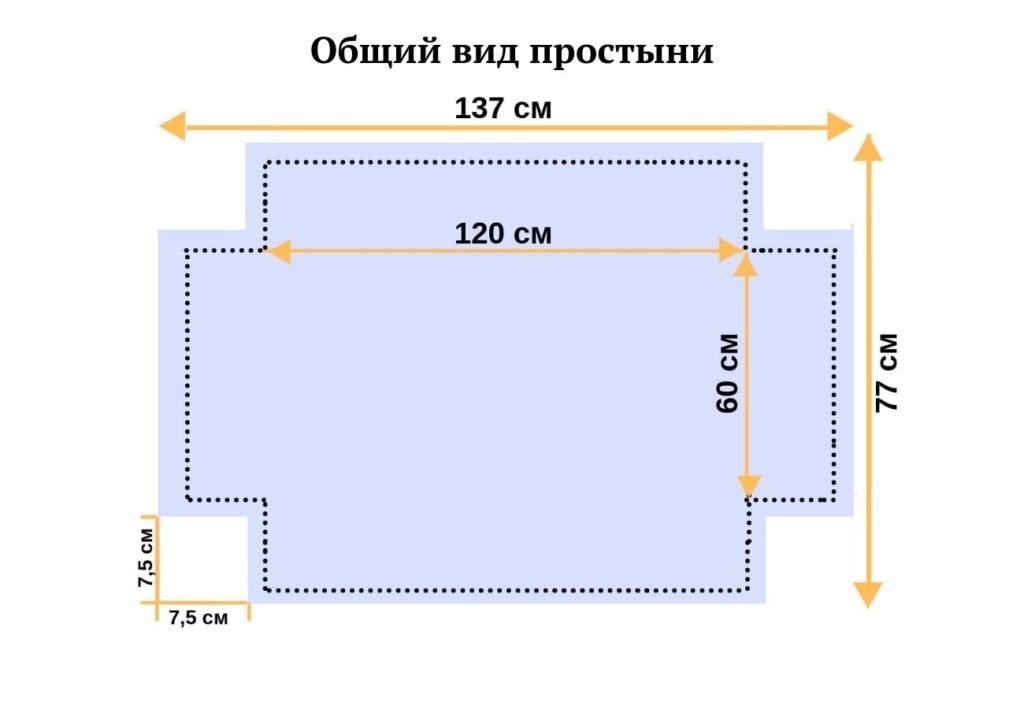
Duvet cover
- Tuck and stitch all raw edges.
- Fold the pattern in half with the right side inward.
- Sew the top and side of the duvet cover.
- Visually divide the lower part into 3 parts: two side parts, 40 cm each and a central part 20 cm (hole for inserting a blanket).
- Sew the side pieces, leaving the center hole. Unscrew the product.

Borticov in the crib
Soft sides will protect the baby from damage. To make them, you will need to pick up a denser fabric. As a filler, you can use a synthetic winterizer, foam rubber or holofiber.
- The pattern will be rectangular. For the long sides, you need pieces measuring 120 x 40 cm, for the short ones - 60 x 40 cm.
- Sew on all raw edges.
- Sew strong braid or tape to each corner. With its help, the side will be attached to the arena.
- Cut the filler according to the size of the pattern.
- Insert filler and sew each piece.
- A hidden zipper can be sewn into one side. This will allow the filler to be removed before washing.

How to decorate baby bedding
The sides can be decorated at the sewing stage using the rest of the fabric. To do this, you need to prepare a strip about 180 cm long and 7 cm wide. Insert the frill, gathering it, inside the product, sew the edges.
The sheet can be decorated with flounces from the remaining material, sewing them on from all sides. Any item of linen can be decorated with delicate lace, large woven ruffles or soft ribbons.
Tips for sewing a bedding set
An important tip is to abandon embossed, voluminous decor. Small parts such as buttons, locks or Velcro can be harmful to your baby. Do not use adhesive applications - they are not practical and may come off during washing.
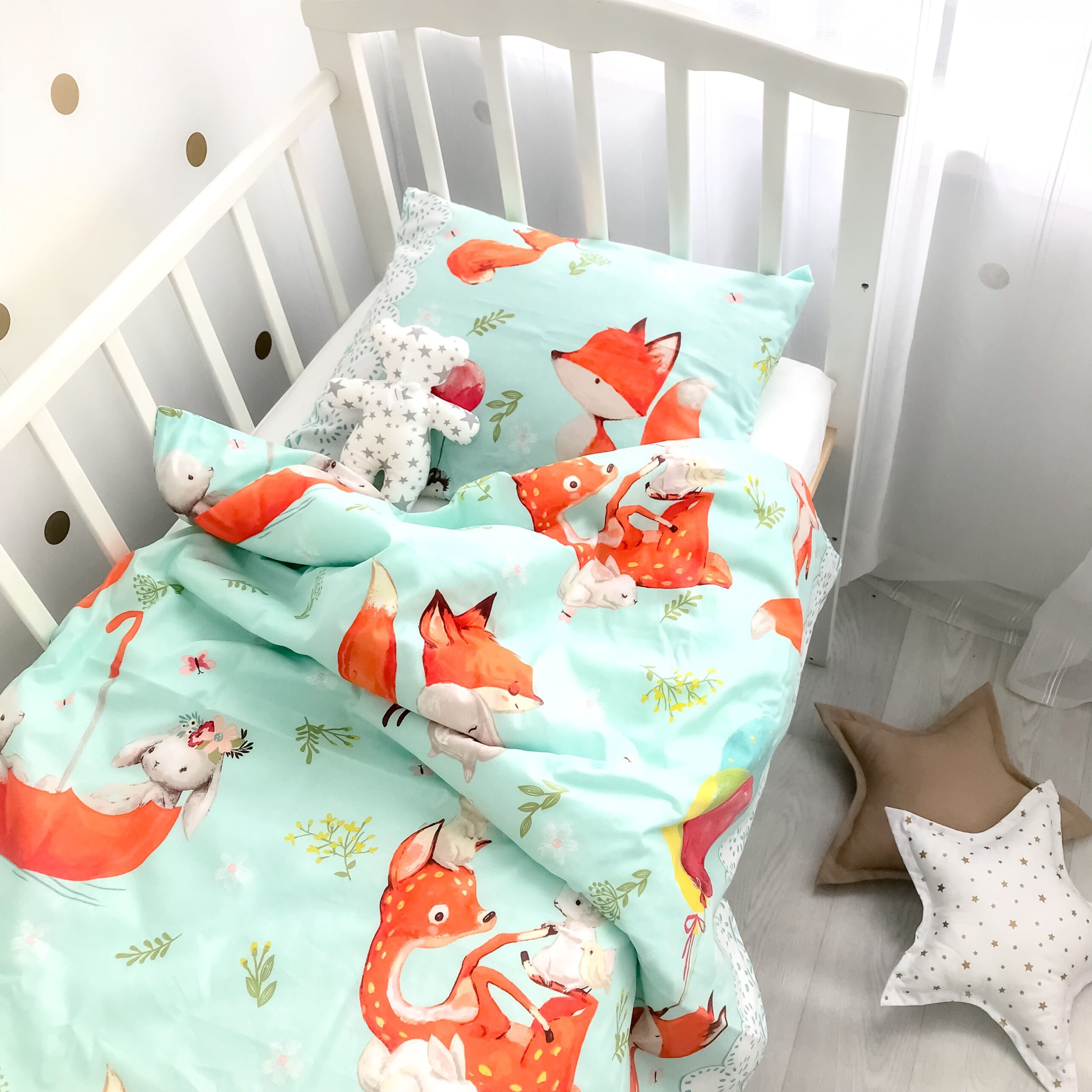
Following the detailed instructions, you can sew a set of underwear for your baby without spending a lot of time. The main thing is to remember that baby bedding should be safe, practical and functional.

Video: sewing bedding for newborns





